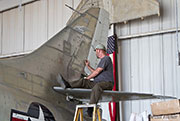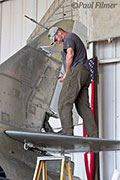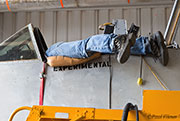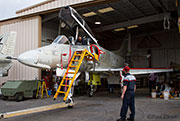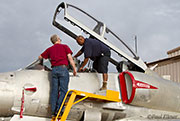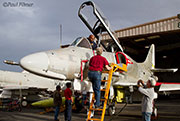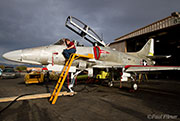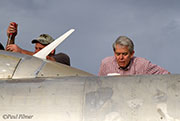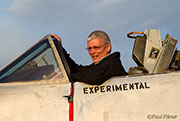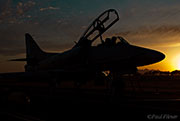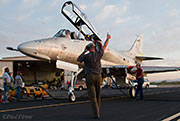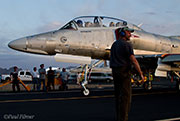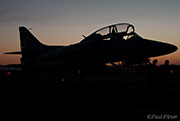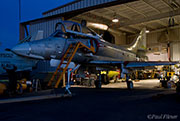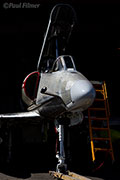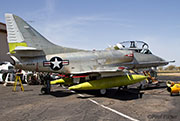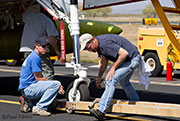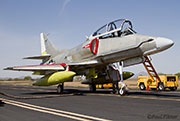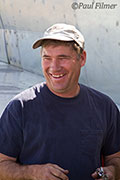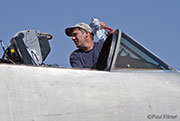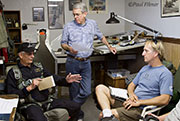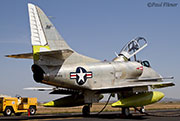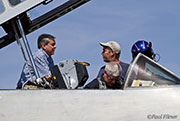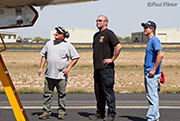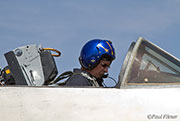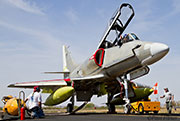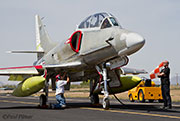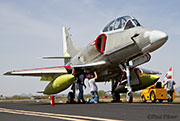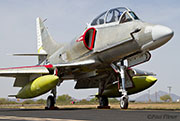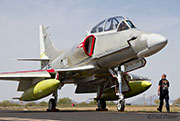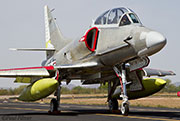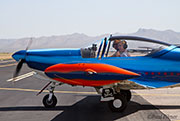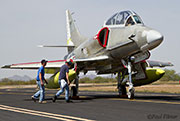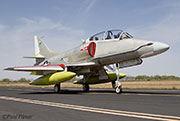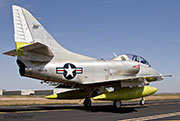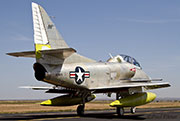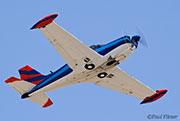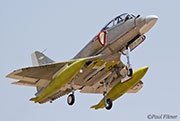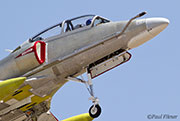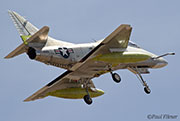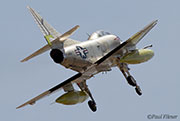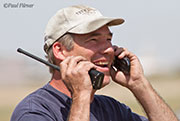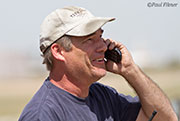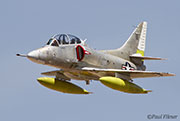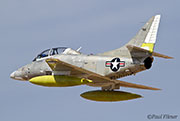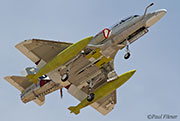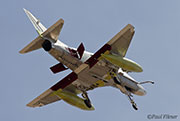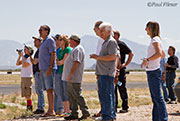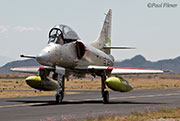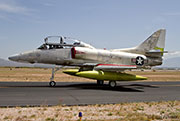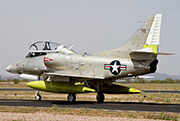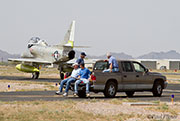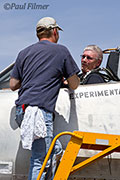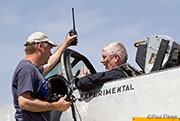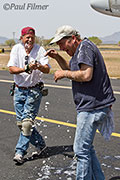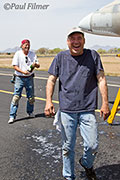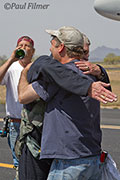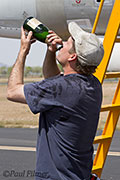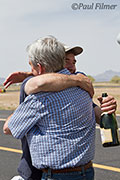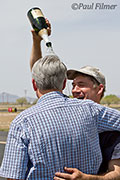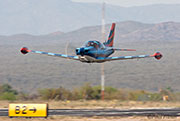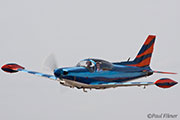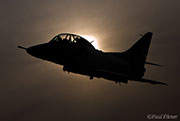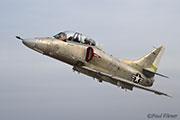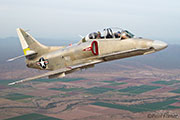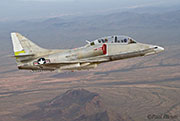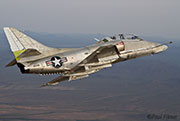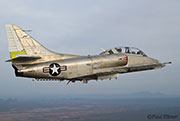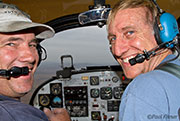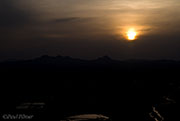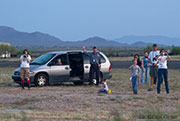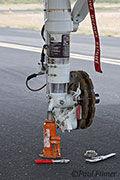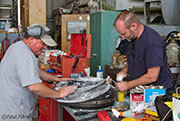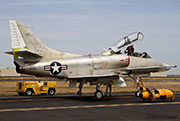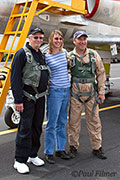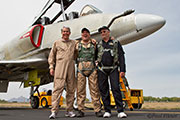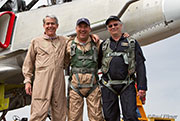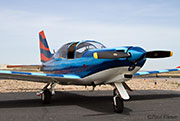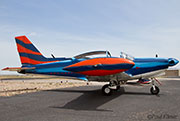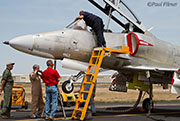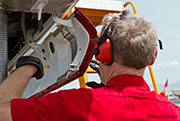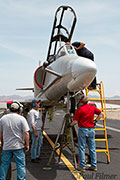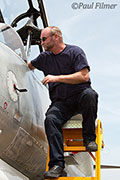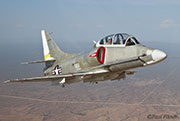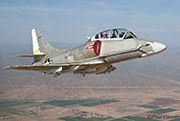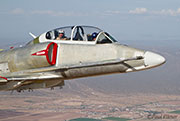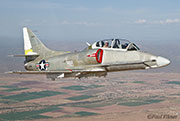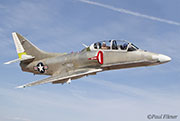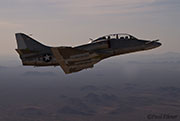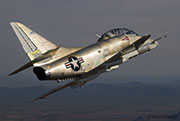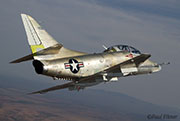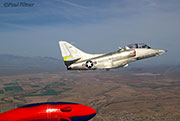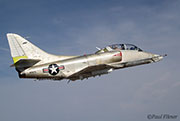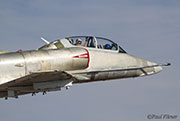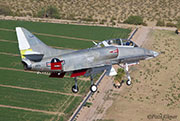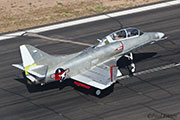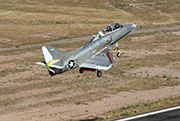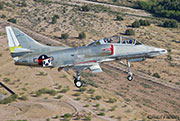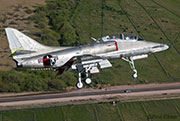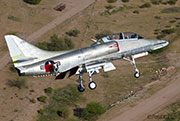"McDougall" Douglas TA-4J First Flight
10:40 on the 18th of April 2010 marked a major milestone in a small corner of Arizona as TA-4J Skyhawk N518TA made its maiden flight after a thorough and lengthy build and restoration.
The work was carried out by Fighting Classics under the watchful eye of Mike "Maj" McDougall with a highly skilled and dedicated crew based in a single hangar at Marana Regional Airport in Arizona.
The aircraft started as an A-4L Bu148602 which was one of a batch of A-4Cs that were converted to A-4L standard and sold to the Malaysian Air Force. This example was one of 36 that were left behind to be used for spare parts and stored at Dross Metals (later called Aircraft Restoration and Marketing) just outside of AMARC. The aircraft were sold as a job lot by the Malaysian Air Force and changed hands a few times before being released to the open market.
The project called for an airworthy A-4 and with the work to be undertaken it seemed sensible to build a 2-seat version to give the most use and appeal from an owner's point of view.
The front fuselage sections of some TA-4Js were available, albeit completely stripped with no sticks, no actuators, rotted wires and no complete lines - basically just the shell with no data tags, and as no aft fuselages from TA-4s were available the decision was made to mate the front half of a TA-4J to the rear of an A-4L. The cockpit basically bolts on to the rear fuselage of a standard A-4 and most major sections are interchangeable with the only modifications being different internal housings to accept different engines. The more powerful J52 engine was used on the original TA-4Js and so the fuselage of this A-4L was modified to accommodate the power plant and the plumbing required.
The basic configuration is as follows: Forward fuselage and engine is TA-4J standard with the aft fuselage, tailplane and wing being A-4L standard. The wings from the Lima model differ from the original Charlie model with the addition of spoilers as did the original TA-4s.
The front and rear cockpits are identical and everything can be performed if needed from the rear seat. The detail of this restoration is incredible. All unnecessary components have been taken out and everything down to the last nut and bolt have been replaced or serviced.
Maj stared his aviation career with Planes of Fame at Chino, CA in 1980 as a janitor in the afternoons and evenings and when his work was done he would help in the restoration shop. He later moved into the shop as a painter working on various aircraft. He was then put in charge of the restoration of an AD-6 Skyraider with other project leads following.
As family became more of a commitment he went into the film business as an electrician in commercials and also helped with some aircraft as a sideline. He moved back to Arizona in 2004 working with Evergreen on a program to kick-start their museum in McMinnville, OR.
He was recruited as a consultant to buy a couple of A-4s but the the owners also wanted to find a shop and after looking around came back and said that they would like Maj to build itif he was interested in starting a new business. This is when the current location was chosen and a hangar was consequently found and rented from Pima Aviation.
So the project started with a single aircraft and a pair of drop-tanks on 13th June 2005 with the original estimate put at 3 years. The first six months was preparation, planning, tooling, finding parts then the build started. Maj worked on his own for the first year of so before recruiting his first employee. At any one time in the restoration there have been a maximum of four people working in the aircraft including him.
Just under five years later and here we are with a fully functioning flying aircraft with experienced test pilot Rick Millson ready to fly the aircraft. Rick is an ex US Navy pilot and Vietnam Veteran with 250 combat sorties and 400 carrier landings under his belt in A-4 Skyhawk's; he also did one tour with the Blue Angels in F11 Tigers and was also a slot pilot using the F-4 Phantom.
Rick has spent 30 years as a corporate and test pilot and also worked for Aviation partners when they designed and tested the winglets on Boeing 737s. He has been a designated examiner with the FAA for the last 20 years on also almost all the jet warbirds, so the flight would always be in great hands.
The first flight brief was planned to be close to the airport using a SIAI Marchetti SF-260 as a chase plane with Roger Tonry at the controls. The plan was to leave the gear and flaps down, climb to 6500 feet and stay below 200kts. Then move to half-flaps, and raise the gear making sure all looked good in the cockpit as well as a visual check from the chase plane. The chase would also lookout for any smoke from the engine and any onbvious leaks of fluid. A couple more cycles of the gear and then fly back into the pattern with a low pass on the cross runway (the hangar is at the end of this runway) then a touch-and-go to landing. Basically exercise everything, and bring it back for the engineers to have a good look over after landing.
They had ground crew with radio communications positioned at the start for the take-off run and at midfield; all were equipped with extinguishers. Terminal Radar Approach Control (TRACON) at Tucson issued discreet squawk codes even though they would be out of all airspace and Tucson International would be a diversion field if there were issues with hydraulics or brakes as they would be able to trap the wire there. For this first flight a pair of drop-tanks were fitted which, as well as being part of the kit, would save the fuselage if a wheels-up landing was required in a worst case scenario.
This first flight was a complete success with just a couple of adjustments to make with items like the Angle of Attack (AOA) indicator, so the project for the ground crew suddenly moved from a restoration to a maintenance job.
On landing Maj was showered with bottle of champagne, which we had strategically hidden the day before - you couldn't have found a happier guy. On the second flight Maj joined us in the SF-260 chase which was combined with a photo sortie to see his pride and joy close up in the air and this elation became overwhelming when it was decided he should go on one of the later flights in the rear seat.
The subsequent flights were made with the drop-tanks off and all that is left is to install the oxygen system, then this aircraft is truly ready to go.
Thoughts from Maj
First flight: As we approached the weekend that the first fights were to take place, (Friday through Monday) I was thinking about the possibility of flying in it but Friday came and went and we had not flown because everything seems to take way longer than you think it will! I had decided I wanted to focus on meeting our flight objectives, which were to make sure our aircraft was operating perfectly as possible, and that the back-seater would be the most qualified person available to assist if that was needed during any of the flights. Don Keating has worked with me full time this entire period as project manager (and friend) as well as flying a full time corporate job. He is a highly competent pilot in many types of aircraft so he was who I wanted in the back seat.
Rick flew the first flight on Saturday morning and the second flight the same evening. During lunch on Saturday I made It clear to Don my feelings on that point and he agreed that we need to get as much out of the next few days as possible. He flew with Rick on the second flight. I saw it from the Air in the SF-260 and it was spectacular! It was amazing to see all those individual pieces I was familiar with, flying as one beautiful machine.
So all in all I was elated that our airplane was in the air and performing well. According to Rick it trimmed out perfectly and was pleased with how it flew, to say the least.
Sunday morning started with our normal preparations and inspections and then to the pre flight briefing. Don called me over and had me stand next to him while he went through frequencies, and contingency plans. As we were finishing up he looked at Rick and sort of rubbed his stomach and said, "Hey Rick I'm not really feeling that good I must have had too much for breakfast. I don't think I will be able to handle flying this morning." Then he put his hand on my shoulder and said, "Maj, Do you think you would mind taking my place? You would be doing me a big favour." I wasn't sure what I was hearing but I didn't have to be asked twice and I was completely taken by surprise.
I strapped into the back seat and looked around while everyone got ground equipment started. And it just seemed surrealistic. However my flight was not to happen until 16:00 that afternoon because before we got moving we had to change a tyre due to tread separation. That took an hour and we were ready to go again. I did get a take off which is indescribable the amount of acceleration you feel, we broke ground... gear handle up, and didn't get a nose gear up indication. My heart was in my throat. Rick cycled the gear once, still did not get the indication so put the gear down and we landed. I was still in awe of what it felt like to be in the air in this airplane. It took the next 6 hours to troubleshoot the forward nose gear door uplock. I just kept telling myself these are nice squawks to have on the first flights of an airplane that wasn't an airplane when we started. We sorted it out and were back in the airplane by around 16:00 and this time the gear was up and in the wells! I was elated. It was interesting to me as a pilot that I really didn't want to fly the airplane in this flight because I just wanted to look around at it while we were in the air because I had at least 2000 hours in this cockpit already but now I was doing 200kts at 3000 feet above the ground. There were no words to describe how amazing it felt.
We flew off of Rogers wing for a while, Paul took pictures and after they had gotten their pictures and Rick said, "See ya later boys." We went from 160kts to 250kts in a blink of an eye. We flew around for another 10 or 15 minutes and I enjoyed every second of it. We did a roll, a low pass, and a touch and go. During that whole time I felt elated for being at this point in our project. I was humbled by the amount of work and help it took to get here, and I was in awe that this wasn't a dream (I was really flying in an A-4). The airplane that I use to watch as a kid land at El Toro, and see at airshows was the airplane that I was now flying in. I was taking in a view that I never would have imagined I would ever get to see.
We flew 3 times on Monday and our last 2 flights we had no squawks to work.
I still don't really have words that describe how I felt through the course of the weekend. We worked our tails off, and we saw the airplane fly multiple times. The whole time we were doing this I was thinking, "This is my job. This is what I do. How did I get so lucky? Thank you Lord!"
The Last Flight on Monday
After the second flight on Monday I met Don and Rick at the bottom of the ladder and they were pleased to report we had no squawks! We were going to do a quick turn and inspect the aircraft and get one more flight before Don had to leave for home.
Rick was elated it was a beautiful flight and the airplane felt great. Rick's phone rang and it was a call from a lifelong friend, Frank. I began inspecting the airplane to get it ready for the final flight of the day when I heard that Rick had lost someone near to him. It turned out that his friend who phoned was in the process of dying and was calling to say goodbye. After some time had passed Don was talking to Rick and said we've accomplished our goals and under the circumstances it would be fine to call it a day. Rick however mentioned that his friend Frank had encouraged him to, "keep flying as long as he had an airplane to fly".
We dedicated the last flight of the day to Rick's buddy Frank Chesley. Don put his hand on Rick's shoulder and said, "It's your airplane. You do whatever you want this flight." It really put some special meaning to our last scheduled flight of the weekend. Rick roared down the runway and picked up the gear and held it at about 25 feet or so and when he reached the end of the runway he pulled it straight up and climbed out of sight. We were all with Rick right then at that moment. It seemed to make that flight a little more special than all the rest.
Frank Chesley passed away at 05:00 on 21st April 2010.
Folks that worked on the aircraft
Greg Klein, Mike Pannell, Roberto Ramos, Jae Williams, Alfred Hudgin, Chris Straughn, Seth Chandler, Stacy Beardsley, Ken De Cook, Larry Gutierrez, Bob Fox, Drabbs, Jeff Nelson, Jamie Sego, Ed Wenner, Ashley Baker, Ed Miller, Chad Nichols, Robert Bingham and Bryan Winters.
As well as all the people mentioned in the article the author would also like to thank Roger Tonry without whom some of these photos would have been impossible to capture.
